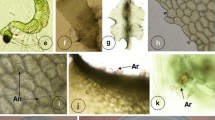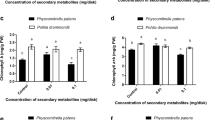Abstract
Axenic cultures of two moss taxa viz. Bryum dichotomum Hedw., an acrocarpous moss and Entodon macropodus (Hedw.) Müll. Hal., a pleurocarpous moss were established by inoculating their spores into agar media. Germination, growth, development and comparative morphogenetic studies of these two growth forms were done. In B. dichotomum, protonemal buds developed on caulonema, while in E. macropodus, buds were produced on chloronema. Sub culturing of B. dichotomum gave rise to new individuals through chloronemal and caulonemal stage, while E. macropodus it directly regenerated into new gametophytes. In old culture under low moisture conditions, asexual diaspores namely, protonemal bulbils B. dichotomum and protonemal brood cells E. macropodus were formed.


Similar content being viewed by others
References
Sabovljevic A, Sabovljevic M, Jockovic N (2009) In vitro culture and secondary metabolite isolation in bryophytes. In: Jain SK, Saxena PK (eds) Protocols for in vitro cultures and secondary metabolite analysis of aromatic and medicinal plants. Humana Press, Springer, New York, pp 117–128
Frank W, Decker EL, Reski R (2005) Physcomitrella patens is highly tolerant against drought, salt and osmotic stress. Planta 220:384–394
Decker EL, Reski R (2008) Current achievements in the production of complex biopharmaceuticals with moss bioreactors. Bioprocess Biosyst Eng 31:3–9
Cove DJ, Bezanilla M, Harris P, Quatrano R (2006) Mosses as model system for the study of metabolism and development. Ann Rev Plant Biol 57:497–520
Duckett JG, Burch J, Fletcher PW, Matcham HW, Read DJ, Russell AJ, Pressel S (2004) In vitro cultivation of bryophytes: a review of practicalities, problems, progress and promise. J Bryol 26:3–20
Rowntree JK (2006) Development of novel methods for the initiation of in vitro bryophyte cultures for conservation. Plant Cell Tissue Organ Cult 87:191–201
Awasthi V, Nath V, Asthana AK (2010) In vitro propagation of the endemic and threatened Indian liverwort: Cryptomitrium himalayense Kash. Curr Sci 98:1440–1441
Rowntree JK, Pressel S, Ramsay MM, Sabovljevic A, Sabovljevic M (2011) In vitro conservation of European bryophytes. In Vitro Cell Dev Biol Plant 47:55–64
Awasthi V, Asthana AK, Nath V (2013) In vitro study on the reproductive behavior of the endemic and threatened Indian liverwort: Cryptomitrium himalayense Kash. Cryptogam Bryol 34:313–323
Nishida Y (1978) Studies on sporeling types in mosses. J Hattori Bot Lab 44:371–454
Duckett JG, Schmid AM, Ligrone R (1998) Protonemal morphogenesis. In: Bates JW, Ashton NW, Duckett JG (eds) Bryology for the twenty first century. Maney Publishing and British Bryological Society, Leeds, pp 223–246
Duckett JG, Ligrone R (1992) A survey of diaspore liberation mechanism and germination pattern in mosses. J Bryol 17:335–354
Sabovljevic M, Bijelovic A, Dragicevic I (2003) In vitro culture of mosses: Aloina aloides (K.F. Schultz) Kindb., Brachythecium velutimum (Hedw.) B.S.&G., Ceratodon purpureus (Hedw.) Brid., Eurhynchium praelongum (Hedw.) B.S. & G. and Grimmia pulvinata (Hedw.) Sm. Turk J Bot 27:441–446
Pressel S, Duckett JG (2009) Studies on protonemal morphogenesis in mosses. XII. Ephemeropsis, the xenith of morphological differentiation. J Bryol 31:67–75
Awasthi V, Nath V, Asthana AK (2010) On the culture of a pleurocarpous moss Entodon laetus (Griff.) Jaeg. Natl Acad Sci Lett 33:145–148
Vujicic M, Sabovljevic A, Sabovljevic M (2011) Axenically culturing the bryophytes: establishment and propagation of the moss Hypnum cupressiforme (Bryophyta, Hypnaceae) in in vitro conditions. Bot Serbica 35:71–77
Awasthi V, Asthana AK, Nath V (2012) In vitro propagation of an epiphytic pleurocarpous moss Erythrodontium julaceum (Schwaegr.) Par. J Bryol 34:140–144
Awasthi V, Nath V, Pande N, Asthana AK (2012) Morphogenetic study and in vitro propagation of two mosses: Philonotis thwaitesii Mitt. and Brachythecium plumosum (Hedw.). Taiwania 57:27–36
Knop W (1865) Quantitative Untersuchungen uber die Ernahrungsprozesse der Pflanzen. Landwirtseh Vers Stn 7:93–107
Kaul KN, Mitra GC, Tripathi BK (1962) Responses of Marchantia in aseptic culture to well known auxins and antiauxins. Ann Bot 26:447–466
Bopp M (1983) Developmental physiology of Bryophytes. In: Schuster RM (ed) New Manual of Bryology, vol 1. The Hattori Botanical Laboratory, Nichinan, pp 276–324
Nath V, Awasthi V, Asthana AK (2009) In vitro propagation and reproductive biology of moss Funaria hygrometrica Hedw. Int J Plant Reprod Biol 1:103–108
Sood S, Chopra RN (1973) A record preponment of bud induction in the moss Entodon myurus. J Plant Physiol 69:390–393
Andrew S, Redfearn PL (1965) Observations on the germination of the gemmae of Hyophila tortula (Schwaegr.) Hampe. Bryologist 68:345–347
Vashistha BD, Chopra RN (1984) Production of protonemal gemmae in culture by the moss Didymodon recurvus (Griff.) Broth. New Phytol 97:83–86
Pressel S, Matcham HW, Duckett JG (2007) Studies of protonemal morphogenesis in mosses. XI Bryum and allied genera: a plethora of propagules. J Bryol 29:241–258
Spiess LD, Lippincot BB, Lippincot JA (1971) Development and gametophores initiation in the moss Pylaisiella selwynii as influenced by Agrobacterium tumefaciens. Am J Bot 58:726–731
Salisbury FB, Ross CW (2002) Plant Physiology. CBS Publications and Distributors, New Delhi
Glime JM (2007) Ecophysiology of development: brood bodies. Bryophyt Ecol, Vol 1. Michigan Technological University and the International Association of Bryologists. http://www.bryoecol.mtu.edu. Accessed 6 Oct 2012
Rowntree JK, Duckett JG, Mortimer CL, Ramsay MM, Pressel S (2007) Formation of specialized propagules resistant to desiccation and cryopreservation in the threatened moss Ditrichum plumbicola (Ditrichales, Bryopsida). Ann Bot 100:483–496
Acknowledgments
One of the authors (VA) is grateful to the University Grant Commission, New Delhi for providing the financial assistance under UGC-SAP (BSR) Research Fellowship Scheme.
Conflict of interest
The authors declare that they have no conflict of interest.
Author information
Authors and Affiliations
Corresponding author
Rights and permissions
About this article
Cite this article
Awasthi, V., Bisht, A.K. & Pande, N. Morphogenetic Studies on Two Mosses, Bryum dichotomum and Entodon macropodus Grown In Vitro. Proc. Natl. Acad. Sci., India, Sect. B Biol. Sci. 86, 421–427 (2016). https://doi.org/10.1007/s40011-014-0463-z
Received:
Revised:
Accepted:
Published:
Issue Date:
DOI: https://doi.org/10.1007/s40011-014-0463-z




